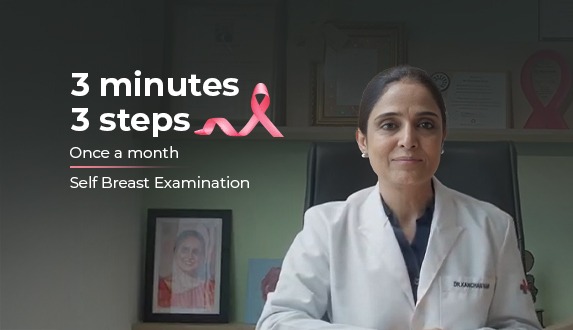Breast Self Examination

YOUR RITUAL OF SELF-CARE
3 Minutes. 3 Steps
STEP 1: MIRROR EXAMINATION
- Stand straight in front of a mirror
- Look closely at the shape and skin of both breasts
- Raise both arms above your head
- Now place your hands on your waist and press gently
STEP 2: PHYSICAL EXAMINATION
- Raise your right arm and place it behind your head.
- Use the three fingers of your left hand to check your right breast and vice versa. Use light pressure, like a soft massage.
- Move your fingers in circles, up-down, and around the nipple
Feel for lumps, knots or any unusual mass, with or without pain.
STEP 3: NIPPLE CHECK
- Stand straight and gently press each nipple one after the other.
Check for nipple discharge. If watery or blood-stained, seek medical advice at the earliest — even a single episode should not be ignored.
If you notice any unusual changes, consult a doctor without delay.

Remember: cancerous lumps are often painless!
What Are The Early
Signs Of
Breast Cancer?
See a specialist if you notice:
- A new lump or thickening in the breast, chest, or armpit.
- Changes in the size, shape, or appearance of a breast
- Skin changes like dimpling (orange-peel texture), redness, scaling, or puckering
- Nipple inversion, burning, itching, or sores
- Nipple discharge (especially if bloody or watery)
- Swelling in the armpit or near the collarbone
- New onset of pain in the breast or armpit
Case studies
Real patient journeys that highlight our expertise, compassion, and successful outcomes in breast cancer care.






